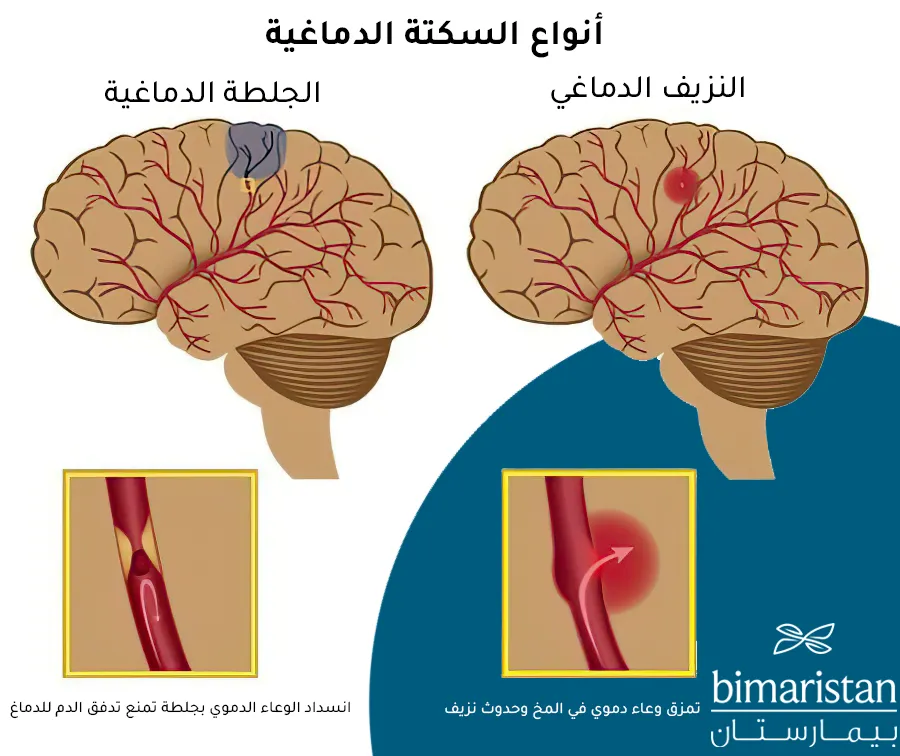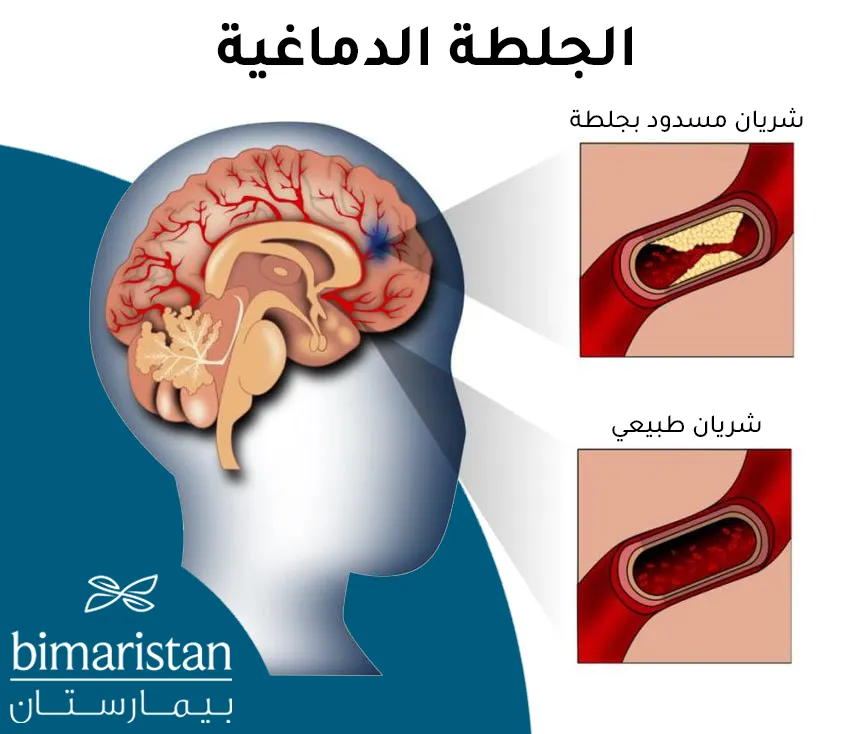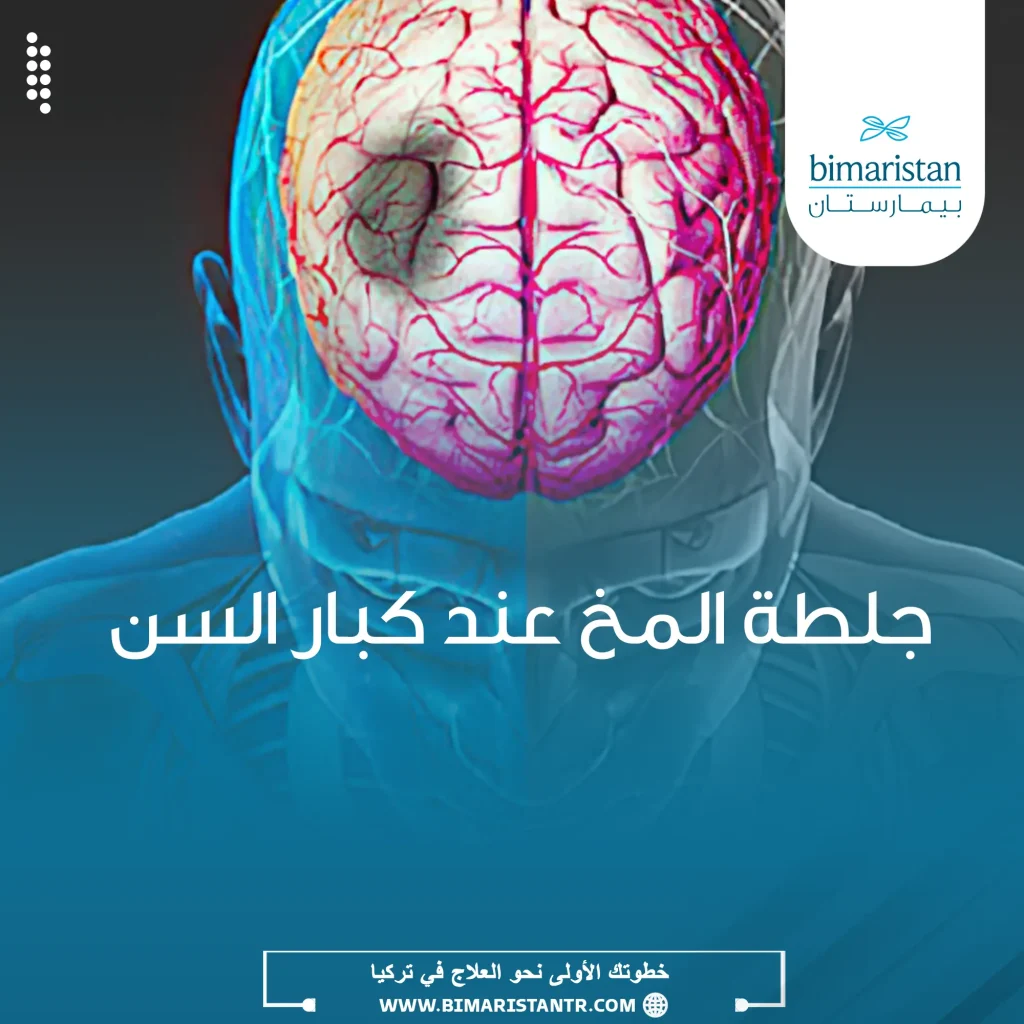معرفتك لأعراض الجلطة الدماغية وهي في مراحلها الباكرة قد يساهم في إنقاذ حياتك وحياة من حولك، إذ تعتبر جلطة المخ عند كبار السن من أشيع أسباب الوفيات المفاجئة.
يجب على الجميع الإحاطة بأعراض جلطة المخ وخطوات التصرف الصحيح في حال الشك بحدوثها، فالدقائق الأولى قد تكون حاسمة ومصيرية للغاية، فقد يتحدد مستقبل المريض وفرص نجاته من السكتة الدماغية ومضاعفاتها خلال هذه الثواني والدقائق.
تعد جلطات الدماغ المسبب الأول للإعاقات الدائمة عند كبار السن، لذا فإن السكتة الدماغية هي حالة خطيرة تتطلب تدخل سريع بدون أية تأخير أو مماطلة، وتذكر بأن درهم وقاية خير من قنطار علاج، فكيف تتم الوقاية من جلطة المخ عند كبار السن قبل حدوثها؟ وكيف يتم علاج الجلطات الدماغية عندما تحدث؟
ما هي جلطة المخ عند كبار السن؟
في الحالات الطبيعية وعند الأشخاص الأصحاء تعمل الشرايين على تغذية الدماغ بكميات كافية من الدم الحاوي على الأوكسجين حتى تتمكن الخلايا العصبية من القيام بوظائفها جيداً ويستطيع الإنسان عيش حياته بشكل مستقل دون أية مشاكل.
عندما يحدث نقص في إمداد الدماغ بالأوكسجين تبدأ الخلايا العصبية بالمعاناة وقد تصمد لفترة زمنية قصيرة بدون أوكسجين (دقائق قليلة) لحين موتها، وبمجرد تلف الخلايا العصبية يصبح من غير الممكن إعادتها مجدداً للحياة أو تعويضها.
قد تتشكل خثرة تسد الوعاء الشرياني وتعيق تدفق الدم عبر الشرايين المغذية للدماغ وبالتالي يتوقف إمداد المخ بالغذاء الكافي فتموت الخلايا وتبدأ اعراض جلطة المخ بالظهور عند الكبار.
جلطة المخ هي نوع من أنواع السكتة الدماغية عند كبار السن، حيث تقسم السكتة إلى نوعين رئيسيين وهما الجلطة الدماغية التي سنتكلم عنها في مقالنا ونوع آخر يعرف بالنزيف الدماغي.

أعراض جلطة المخ عند كبار السن
من الواجب علينا جميعاً الإحاطة بعلامات وأعراض الجلطة الدماغية بسبب خطورتها وعواقبها المحتملة على حياة من يصاب بها وخاصة كبار السن، فمن خلال معرفتنا للعلامات والأعراض نستطيع طلب المساعدة بأسرع وقت ممكن.
عندما يتعرض الشخص للإصابة بجلطة دماغية عادة ما تظهر عليه أحد هذه الأعراض:
- الشعور المفاجئ بخدر وضعف عضلي في الوجه أو الذراع أو الساق (غالبًا في أحد نصفي الجسم الأيمن أو الأيسر)
- ارتباك وصعوبة في التكلم أو فهم الكلام المسموع
- مشاكل في الرؤية بأحد العينين أو كلاهما (تشويش أو ضعف بصري وقد يحدث عمى)
- صداع شديد ظهر فجأة بدون أية سبب
- الصعوبة في المشي والحفاظ على توازن الجسم
- غثيان وإقياء
قد تظهر لدى مريض جلطة المخ واحدة أو أكثر من هذه الاعراض والتي تتميز بظهورها المفاجئ دون سابق إنذار، ويفضل تذكر التوقيت التي بدأت به اعراض جلطة المخ بالظهور فقد يساعد ذلك في تحديد خطة علاج مناسبة في المستشفى.
أسباب جلطة المخ عند كبار السن
كما ذكرنا سابقاً فإن انسداد الشريان بخثرة تمنع تدفق الدم جيداً للدماغ هو السبب الرئيسي لجلطة المخ عند كبار السن، فقد تساهم العديد من عوامل الخطورة في حدوث الجلطة الدماغية ومن بينها:
تصلب الشرايين العصيدي
كما هو الحال في جلطة القلب فإن مرض تصلب الشرايين هو من أهم اسباب تشكل جلطة المخ عند كبار السن، يسبب هذا المرض تراكم لويحات دهنية حول جدران الأوعية الدموية مما يتسبب بتضيق الوعاء الشرياني أو انسداده بشكل تام فتظهر اعراض جلطة الدماغ.
إن سبب هذا المرض ما يزال غير مفهوم تماماً إلا أنه تم وضع مجموعة من العوامل التي من شأنها أن تزيد من فرص حدوثه كالتدخين، السمنة، نمط الحياة قليل الحركة، إرتفاع نسبة الشحوم في الدم، الإفراط في شرب الكحول، الداء السكري.
ارتفاع ضغط الدم
الضغط الدموي المرتفع هو من الأمراض الشائعة التي ترفع خطر الإصابة بالجلطة الدماغية المفاجئة عند كبار السن خاصةً عندما لا يتم ضبطه جيداً بالأدوية اللازمة، لذا يحب عدم إهمال علاج الضغط خوفًا من احتمال إصابة الشخص بمضاعفات عدة للضغط المرتفع من بينها جلطة المخ.
الرجفان الأذيني
الرجفان الاذيني هو من اضطرابات نظم القلب الشائعة عند كبار السن، إذ تنبض العضلة القلبية دون تناسق بين حجرتيها (البطين والأذين) مما يؤدي إلى تشكل جلطات دموية بالقلب وقد تنتقل هذه الجلطات إلى المخ عبر الدورة الدموية محدثة سكتة دماغية مفاجئة.
نمط الحياة الغير صحي
زيادة الوزن والتدخين مع تناول طعام غير صحي حاوي على كميات كبيرة من الدهون قد يرفع خطر إصابة كبار السن بالجلطة الدماغية، فكبار السن هم أكثر عرضة للإصابة بالسكتة الدماغية من الشباب.

تشخيص الجلطة الدماغية
بمجرد وصول المريض للمستشفى يقوم أطباء الإسعاف بتقييم حالة المصاب وعلاماته الحيوية وأعراضه ومن ثم يتم إجراء هذه الفحوصات بأسرع ما يمكن:
طبقي محوري للرأس
يفيد هذا الاختبار في تحديد نوع السكتة الدماغية التي يعاني منها المريض حيث يظهر النزيف الدماغي على صورة الطبقي المحوري على شكل كثافة بيضاء، ففي حال لم يظهر النزف فغالبًا ما يتعرض المصاب لجلطة إقفارية (نقص التروية)، حيث تعتبر الجلطة الدماغية عند كبار السن أقل خطورة من النزيف إذ أن نزيف الدماغ علاجه أصعب من جلطة المخ.
الفحص العصبي والجسدي
من الاختبارات الروتينية التي تجرى لمرضى الجلطة الدماغية والتي تتضمن سماع دقات القلب وقياس ضغط الدم بالإضافة إلى فحص عصبي يشمل الوظائف الفكرية عند كبار السن مع المقدرة على تحريك الأطراف وفحص الحواس الخمسة والذاكرة.
الرنين المغناطيسي للدماغ
تتميز صورة الرنين المغناطيسي (MRI) بقدرتها على كشف جلطة المخ عند كبار السن بنوعيها النزفية والإقفارية (الجلطة)، إذ يستخدم هذا الجهاز حقل مغناطيسي وأمواج الراديو لإعطاء صور واضحة لنسيج الدماغ وكشف وجود تغيرات غير طبيعية في المخ.
كيفية علاج جلطة المخ عند الكبار
عندما يراجع مريض تظهر عليه أعراض السكتة الدماغية المستشفى يقوم أولاً الفريق الطبي بالتأكد من نوع السكتة في حال كانت ناتجة عن نزيف في الدماغ أو بسبب جلطة في المخ وذلك عن طريق الصور الشعاعية للدماغ.
إذا كان سبب السكتة الدماغية عائد لجلطة، يتم تحديد مكان الجلطة في الدماغ وبعدها يمكن اللجوء لأحد العلاجات التالية:
حقن دواء يحل الجلطة عبر الوريد
هذه الطريقة في العلاج تكون فعالة فقط إذا تم تطبيقها خلال أول 5 ساعات تقريباً من بداية ظهور الاعراض، وكلما كان البدء أبكر كلما كانت فعالية علاج الجلطة الدماغية أفضل.
يلجأ الطبيب لحقن دواء يعمل على تذويب الخثرة وحلها لاستعادة تدفق الدم الطبيعي للدماغ، هذا الدواء يعرف باسم ألتبلاز Alteplase وهو يعطى عبر حقنه بالوريد ويعتبر المعيار الذهبي في علاج جلطة المخ عند تشخيصها بسرعة لدى كبار السن.
حل جلطة المخ وتذويبها بشكل سريع قد يقي من تضرر الأنسجة الدماغية التي تسبب مضاعفات وإعاقات متوسطة إلى شديدة عند كبار السن.
الجراحات الطارئة على الدماغ
في بعض الأحيان وضمن مراكز عصبية متطورة قد يتم إجراء عملية جراحية لمعالجة جلطة المخ عند كبار السن من خلال التداخل داخل الأوعية الدموية والوصول للشريان المسدود إذ يمكن بعدها حقن أدوية تحل الخثرة مباشرةً بداخل الوعاء الحاوي على الجلطة وهذا الإجراء يبقى فعالاً بعد حدوث الجطلة لوقت أطول من حقن الدواء داخل الوريد.
من الممكن أيضًا إزالة جلطة المخ عبر استخدام قسطرة يتم إدخالها عبر شريان الفخذ وصولاً للشريان الدماغي المسدود بجلطة، إذ تجهز هذه القسطرة بدعامة مستخرجة للجلطات، يفيد هذا الإجراء في حالات الجلطات الدماغية كبيرة الحجم وقد يشارك مع الدواء الحال للخثرة، يمكنك مشاهدة فيديو عن هذه العملية في الأسفل.
إعادة تأهيل مرضى الجلطات الدماغية
كما ذكرنا سابقاً فإن جلطة المخ مسؤولة بشكل كبير عن الإعاقات لدى الكبار في العمر سواءً كانت إعاقات حركية (شلل) أو عصبية (صعوبة التكلم، فقدان للذاكرة) لذا يجب الاهتمام جيداً بإعادة التأهيل بعد جلطة المخ عند كبار السن.
تأهيل كبار السن المصابين بجلطات في المخ هو علاج طويل الأمد قد يستغرق شهور أو سنوات ويتم عبر جلسات مع أخصائيين في هذا المجال، يمكنك الاطلاع أكثر عن إعادة التأهيل العصبي بعد السكتة الدماغية.
الوقاية من جلطة المخ قبل حدوثها
من الصعب أحياناً علاج جلطة المخ وتجنب مضاعفاتها حينما يصاب كبار السن بها، لذا فإن الوقاية لها دور أهم من العلاج وتتم عبر ما يلي:
- اضبط ضغط دمك المرتفع
- حمية غذائية صحية بدون الإكثار من الدهون والملح
- الاهتمام بصحة العضلة القلبية
- تجنب التدخين والكحول
- ممارسة التمارين الرياضية بانتظام والحفاظ على وزن صحي
- راقب مستوى الكولسترول بالدم
وبالنهاية فإن جلطة المخ عند كبار السن هي حالة خطيرة يجب أن تولى أهمية خاصة لكونها قادرة على تغيير حياة المريض للأبد، كل فرد منا يجب أن يكون على علم بأعراض الجلطة الدماغية لكي يتمكن من كشفها بأسرع ما يمكن، فكلما تم البدء بعلاج السكتة الدماغية باكراً كلما ازدادت فرص نجاة المصاب من مضاعفات جلطة المخ الخطيرة، فقد تتشكل جلطة الدماغ لأسباب عدة ويمكن عبر تجنب هذه الأسباب الوقاية من الجلطات قدر الإمكان.
المصادر:
